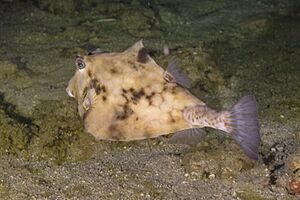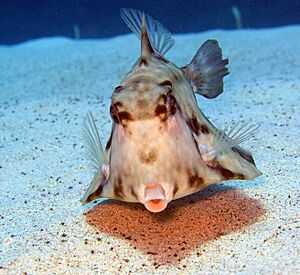Camel cowfish facts for kids
Quick facts for kids Camel cowfish |
|
|---|---|
 |
|
| Conservation status | |
| Scientific classification |
The Tetrosomus gibbosus, often called the camel cowfish, is a unique fish. It gets its name from a small hump on its back, like a camel's. This fish is part of the boxfish family, called Ostraciidae.
Other names for it include helmet cowfish and humpback turretfish. The camel cowfish lives in the warm waters of the Indo-West Pacific region. Since 1988, it has also been seen in the Mediterranean Sea. It likely got there through the Suez Canal. This makes it the first boxfish species found in the Mediterranean.
Some people keep camel cowfish in aquariums. However, they can be tricky to care for.
Contents
What Does a Camel Cowfish Look Like?
A fully grown camel cowfish is usually about 20 centimeters (8 inches) long. But some can grow up to 30 centimeters (12 inches)!
These fish have a special feature: a hard, bony outer shell. This shell is called a carapace. It covers almost their entire body. Only small parts like their mouth, eyes, and gills stick out. Their mouth is small with thick lips. They have a few cone-shaped teeth.
How Does the Camel Cowfish Live?
The camel cowfish has a secret defense. Its body, including its flesh and spines, can be poisonous. If it feels scared or bothered, it can even release a poisonous slime. This poison can be dangerous to other sea creatures and even humans.
These fish are also special because they can change their sex. All camel cowfish are born female. But as they get older, some of them can change into males.
Young camel cowfish often swim together in small groups. As they grow up, they prefer to live alone. The camel cowfish eats many different things. It is an omnivore, meaning it eats both plants and animals. Its diet includes seaweeds, sponges, snails, worms, and small crabs. It finds these foods on the seafloor.
Where Do Camel Cowfish Live?
Camel cowfish like to live in shallow, warm tropical waters. They often hang out in areas with muddy bottoms. You might also spot them near shallow seagrass beds or in coral reefs.
Sadly, in the South China Sea, the camel cowfish is considered an endangered species. This means there are not many of them left there.
Traveling Through the Suez Canal
Have you heard of the Suez Canal? It's a waterway that connects the Red Sea and the Mediterranean Sea. When it opened in 1869, it created a path for marine animals to move between these two seas.
When a sea creature moves from the Red Sea to the Mediterranean Sea and starts living there, it's called a Lessepsian migration. The camel cowfish is one of these travelers. It was first found in the Mediterranean Sea in 1988.
Both the Red Sea and the Mediterranean Sea have similar salt levels and temperatures. This makes it easier for fish like the camel cowfish to move between them. Scientists think that climate changes also encouraged these migrations.
Now, the camel cowfish is considered an invasive species in the Mediterranean Sea. This means it's living in an area where it doesn't naturally belong. It has successfully created a growing population there.
Because the camel cowfish can't swim very far at once, it probably took many generations for them to cross the Suez Canal. It's thought that ocean currents helped by carrying their eggs and young fish north towards the Mediterranean Sea.



